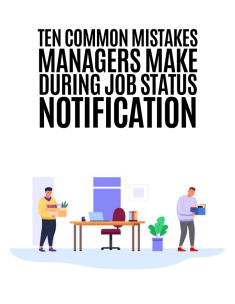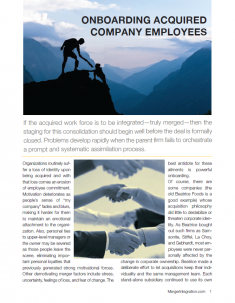Job status notification is a difficult challenge that warrants careful planning and handling. Avoid the following typical mistakes when communicating job status information following the close of the deal:
Mistake # 1: Not being prepared.
Antidote: Get ready.
- Know specifically what your role and responsibilities are regarding this process.
- Thoroughly understand the three different categories of employees (continuing, transitional, and separated) and review the process for dealing with each scenario.
Mistake # 2: Not acting calm and relaxed.
Antidote: Be confident.
- As a leader, it is your job to make people as comfortable as possible throughout the job notification process. If you act calm and confident, they will be more likely to mirror your demeanor.
- Make eye contact when communicating the employee’s job status.
- Make sure your body language is relaxed and calm, yet confident.
Mistake # 3: Talking too much.
Antidote: Stick to the script.
- Be sure not to ask unnecessary questions that complicate the dialogue or lengthen the process. While questions are normally a good way to build rapport, this conversation is not the time to explore how the person is feeling or what they are thinking.
- Emotion may prevent people from listening as well as normal, so be clear and concise. Speak a little more slowly than you normally might.
- Remember that this conversation is not a debate. The decision has been made and you are simply responsible for communicating that decision effectively.
Mistake # 4: Spending too much time.
Antidote: Be brief.
- Job status notification conversations should be brief; no longer than five to ten minutes at most.
- You are only responsible for communicating the job status decision, not all the details of separation, outplacement, transition agreements, or job offers, so just make sure you handle the actual decision communication well.
- If the employee refuses to leave or continues to ask questions beyond what is productive, simply say, “I’d like to end this meeting now. We have other resources that will answer your questions and help you with your concerns.”
Mistake # 5: Trying to be a specialist.
Antidote: Be an authentic leader.
- Don’t try to explain details you don’t fully understand. HR specialists will be present to cover the more complex questions related to benefits and compensation. They will also support you with responses to questions about transition agreements and job offers.
- Focus your time and attention on being an expert on the notification process, the quality of communication, and the interpersonal skill required to conduct these conversations with dignity, respect, and professionalism.
- By honest and authentic. If the employee asks questions you can’t answer, make a note and commit that someone will follow up with a response as soon as possible.
Mistake # 6: Responding to emotion with emotion.
Antidote: Be calm and compassionate.
- Be prepared for emotional reactions. You can expect a full range of responses, including denial, anger, fear, sadness, curiosity, frustration, confusion, and/or relief.
- Don’t try to prevent people from feeling these emotions. Emotions are there to help people work through the transition they are experiencing, so you should allow these emotions to do their work.
- Just make sure that you don’t allow their emotions to escalate your response. You may become the target of their emotion temporarily, but don’t take it personally. Just take a deep breath, compose yourself, and demonstrate respect and compassion for the pain they are feeling.
Mistake # 7: Feeling guilty...





